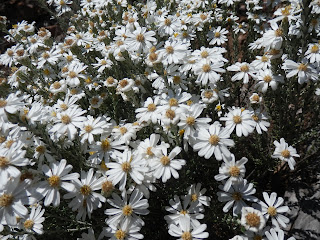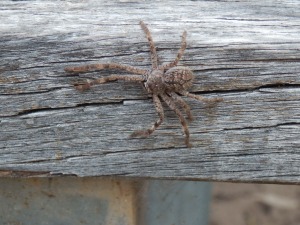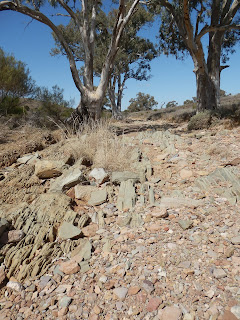This walk has been tougher than I expected. It's not that 10ks is completely beyond me yet, so perhaps it was the heat and rocky gradient that had me puffing and looking for excuses to stop every few metres.
I'd been longing for years to see the famed beauty of outback wildflowers and the
And so, the exhausting expedition at the southern end of the Flinders Ranges became an excuse to stop, bend and click, walk a bit, then stop, bend and click.
But ... there's always a but isn't there?
I stuffed up far too many of the photos. Whether it was my dark glasses with their out of date prescription, or the sweat dripping into my eyes, or just plain stupidity, and not checking after each shot, too many of the photos are out of focus to be considered worth sharing to even the most generous and forgiving reader.
Damn.
However, a few were worth sharing and many flowers were asking to be described in all their rich, vibrant glory:
Minute hair like stems with a lone brilliant yellow flower 4ml in diameter (about 1/8inch) emerged from the harsh rocky soil, not a dense carpet, but singly, apparently alone, but actually in sparse clusters. They stretch the length of my thumb to the sky, fragile, delicate, exquisite in their perfection.
Other, vine-like, straggle up a sparse bush, drooping vine like clusters of 'egg and bacon' - golden/rust pea-like flowers, almost hidden by the scratchy leaves and insignificant yellow flowers of the host bush.
Puffballs of gold, wattles of assorted varieties. Generous, vivid yellows contrast dramatically with the red soil. Some have harsh spiky leaves,
others more forgiving for a bare armed passer-by.
Small yellow flowers (so much yellow!) like buttercups, improbably located out here, but appear to follow the sun. I couldn't bear to pick any as they'd struggled so valiantly to bloom in these harsh conditions.
Tiny mauve and white flowers, mostly single stemmed, but sometimes growing in clusters, then, what appeared to be a miniature iris next to some "daisy chain daisies". Is that possible?
Crisp everlasting daisies, with balls of yellow petals, joyous, long-lasting as their name suggests. Starbursts of yellow and white, just like a child's painting of a flower, complete with foraging bee.
At one place there were sweeping drifts of daisy bushes, the profusion of pure white flowers improbably clean in this dusty land.
Puffy mauve delicate things, ranging all the way through to rich regal purples, some minutely fringed like a royal ruff.
White and yellow, infinitesimal things; kneeling on unfriendly, rocky ground to try to capture the delicate beauty and fragile nature of these tiny beauties. You can just see some of the yellow ones in the photo above, the fringed mauve flower is about 1cm (less than 1/2 inch) in diameter - the yellow flowers are tiny!
And ants, everywhere ants. An abundance, a profusion of ants. Do you know that song "Itsy bitsy fuzzy wuzzy worm" and one line is "big fat juicy ones, long thin tiny ones" well, this was the ant version of that song!
Ants aren't my favourite creature on earth. I acknowledge their importance in removing debris and changing it from one form into another. But I don't like them on me, crawling in a focused, meaningful way up an unprotected limb. Ants aren't friendly.
Busy ants, scurrying ants, some neat and orderly, playing follow the leader with deep intent, others bustling, some appear frantic and undisciplined, seem to spiral out of control. So many varieties - small, medium, large, fat, thin, dark, or pale and translucent, all moving as if the other types simply didn't exist. Billions upon billions of ants.
And the flies. The constant background drone of flies eternally buzzing, crawling, tickling, crawling up under your glasses to drink at the moisture around your eyes. And for goodness sake, don't breathe deeply through your mouth. You'll likely breathe one in and spend the next long minutes coughing pathetically to evict the horrible little bugger from the depths of your throat where it will have got caught and is making an unhappy nuisance of itself.
... and start thinking about recipes for ferral goats and how much better for the environment it'd be if those culled were somehow able to be sold for food.
The gold of the Flinders Ranges wattle on the right, looking over The Dutchmans Stern more or less toward the plane where Quorn is located and Southern Flinders Ranges.
.































